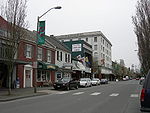Burlington-Edison High School

Burlington-Edison High School (commonly abbreviated to B-EHS) is a public high school in Burlington, Washington. It serves students in grades 9–12 in the Burlington-Edison School District, including the communities of Burlington, Bow, Edison, and Alger. The current administration is made up of principal Jeffery Baines, and assistant principals James Campbell and Jeff Demorest. The mascot is the Tiger, and the school colors are blue and gold. In 1943, Burlington High School combined with Edison High school to form Burlington-Edison High School. The Edison High School mascot was the Sparkplugs and their colors were red and white. Burlington-Edison High School kept the Tiger mascot when the schools combined, as well as their blue and gold colors. Burlington-Edison's main rival is Mount Vernon High School.
Excerpt from the Wikipedia article Burlington-Edison High School (License: CC BY-SA 3.0, Authors, Images).Burlington-Edison High School
North Burlington Boulevard,
Geographical coordinates (GPS) Address Website Nearby Places Show on map
Geographical coordinates (GPS)
| Latitude | Longitude |
|---|---|
| N 48.477777777778 ° | E -122.33666666667 ° |
Address
Burlington High School
North Burlington Boulevard 301
98233
Washington, United States
Open on Google Maps





